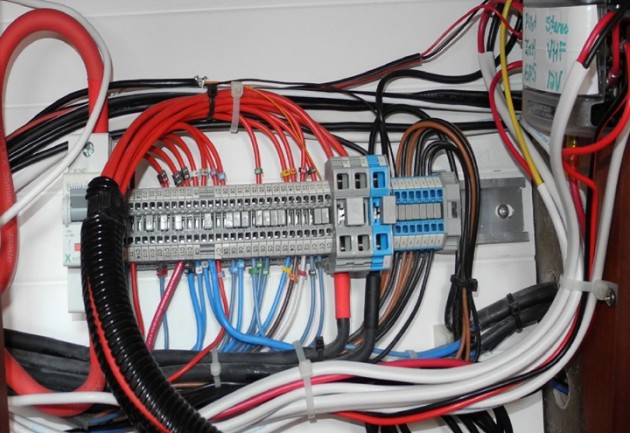Is a DIN Rail System OK for Mounting Wires on a Boat?
Some compression-type mounting systems are compliant with ABYC standards and some aren't. It's easy to check.
October 10, 2014
Question: Here's a picture of the wiring system on my new boat. People have told me that this type of “DIN rail” wiring is not compliant with ABYC standards and that it is prone to corrosion and actually creating loose electrical connections over time. What’s your take on this method?

Compression-type connections made on a DIN rail like this one often work best with single-strand wire. Multi-strand wire doesn't always fit neatly, and should be secured with plate pressure, not by direct contact with screws, which can cut the strands and reduce current flow.
Answer: Excellent question, and my answer is, “It depends.” Within ABYC standard E-11, several statements are made relative to securing wire at such compression-type termination points. (DIN stands for “Deutsches Institut für Normung,” which were the original German specifications for this type of rail-based mounting system.)
First, standard E-11 requires multi-stranded cabling only. Some of the DIN rails utilize a brass spring-loaded locking gate that works great with single-strand conductors, but terribly with thin multi-strand cable. With that type, you just push the wire into the brass gate and the gate opens enough to allow the wire to enter. Then it’s clamped by the spring pressure. Using this type with multi-strand cable almost guarantees that some of the fine strands won’t make it into the small hole that guides the wire into the clamp. I can’t see any stray strands in the photo you sent in, so that’s a score on the positive side of this.
If the method of securing the conductors uses a small set screw, which I think I see in your photo, then the only restricting criteria in the standard is that the screw does not bear directly against the thin individual strands of the multi-strand cable. The risk here is that as you tighten the screws, they dig into the small strands, which can break, potentially impacting the current-carrying capability of the cable in question.
ABYC requires that the screw bear against a plate inside the receiving hole for the cable, and that as the screw gets tightened, the plate compresses against the fine strands of the cable, ultimately locking everything nicely in place with no damage to the individual strands.
So, to find out if your system is compliant with standards, loosen one of the screws, pull one of the conductors (cables) out, and look inside the hole. If all you see is the screw and no plate, then the DIN rail is not compliant. If a small plate is in place, all is well. If the plate is not present, the easiest way to make the setup compliant is to crimp on some proper-sized pin-type connectors and lock then in place with the set screws.












